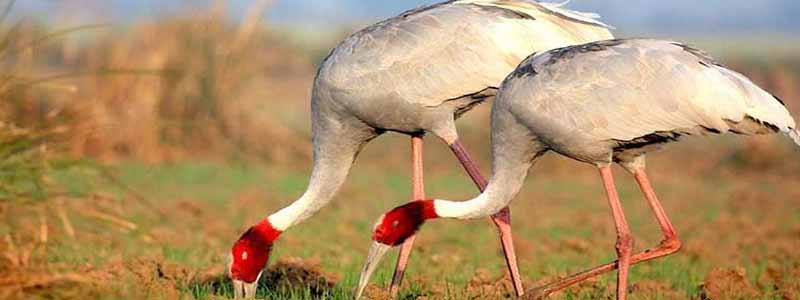Bharatpur National Park is one of the finest bird sanctuaries in the world and it is also known as Keoladeo Ghana National Park. It is a sanctuary that provides security to faunal species. Keoladeo, the name comes from an old Hindu temple that is dedicated to God Shiv and remains at the main point of the keoladeo national park. “Ghana” implies thick, alluding to the thick woods, which used to cover the region. Relaxing indigenous water-feathered creatures and also transient water flying creatures and waterside winged creatures, this sanctuary is likewise possessed by Sambar, Chital, Nilgai, and Boar.
While a large portion of India’s park has been produced from the chasing predicament of royal India, Keoladeo, famously known as Bharatpur Wildlife Sanctuary, is maybe the main situation where the environment has been made by a maharaja. In prior times, Bharatpur town used to be flooded frequently every monsoon.

History of Bharatpur National Park
Bharatpur National Park is a man-made garden, Maharaja Suraj Mal of Bharatpur built this bird sanctuary 250 years ago. There is a temple of Lord Shiva in the centre of this garden which is known as Keoladeo here, hence the name of this garden was named Keoladeo.
There is a natural slope at this place, due to this, at that time flood situation was created at this place during the rainy season, to avoid this, Maharaja Surajmal constructed the “Ajan Bund” here in the middle of 1726-1763. The dam was constructed at the site of two rivers “Gambhiri and Banganga Sangam” flowing here Wildlife in Rajasthan.
From 1850 onwards, the kings of Bharatpur Tour started using this place as a hunting ground. Along with this, the king started organizing annual bird hunting in this zoo to keep the British Viceroy happy. In 1938, the then British Viceroy of India, Lord Linlithgow, along with his colleague Victor Hope, hunted over 4,273 birds a day, with the largest number of birds such as “Mallards and Teals” being hunted on that day.
Under the Rajasthan Forest Act 1953, this Bird Sanctuary has been included in the category of a reserved forest, the last hunting in this Bird Sanctuary was organized in 1964, the former Maharaja of Bharatpur reserved the rights to hunt here till 1972. On 13 March 1976, the area was given the status of a Bird Sanctuary, and in October 1981, under the Wetland Convention, the place was given the status of a Ramsar site.
This Bird Sanctuary got the status of National Park on 10 March 1982, since then the name of the Bird Sanctuary has become Keoladeo Ghana Bird Sanctuary. At the World Heritage Convention held in 1985, this National Park has declared a UNESCO World Heritage Site.
After being declared a national park, in 1982, the government banned farming and protecting domesticated cattle and taking fodder within the protected forest, leading to many violent clashes with local residents and the government over the region, eventually In 2004, the government had to accept the demands of the farmers, after which the government drastically cut the water being sent to this zoo Bharatpur National Park.
The water supply to this park was reduced from 15,000,000 cubic feet earlier to just 510,000 cubic feet. Since this decision of the government, there has been a huge change in the natural environment of this garden which was very terrible, after the water cut, most of the marshy land here has become pleasantly useless, resulting in those who come here for breeding.
Most migratory birds now fly away to Garhmukteshwari in Uttar Pradesh, located near the river Ganges, 90 km from this place.
Places to Visit in and around Bharatpur Bird Sanctuary
Several tourist attractions encircle Bharatpur Bird Sanctuary. Each point of interest, from historic forts to enticing museums, gives you a unique experience. After exploring the park, you can discover nearby places. Below is the list of tourist places near this park.
- Lohagarh Fort
- Government Museum
- Deeg Palace
- Ganga Mandir
- Bharatpur Palace
Best Time to Visit Bharatpur National Park
Bharatpur National Park Winters offer the best time to visit the region. The weather is extremely pleasant and allows you to wander in the park throughout the day. Additionally, witnessing the migratory birds makes it a pleasure to visit during these months. Make sure you carry warm clothes. Also, if you wish to take an early morning stroll, it’s better to have something warm to cover your ears.
Tourists can visit the sanctuary any time between the months of October and March. For bird enthusiasts and photographers, the best time might be between December and February. With a clear view and great light, you’ll end up with some splendid shots. Also, the migratory birds will be a treasure to add to your clicks. January is usually a foggy month. Make sure you check the weather before planning a visit. March and November are great if you wish to visit during the relatively offseason months and enjoy some peaceful time.
How to Reach Bharatpur National Park
Bharatpur National Park is one of the famous destinations in Rajasthan. It is connected through air, road, and train with other cities of India.
By Air:- The nearest airport from Bharatpur Bird Sanctuary is Agra Airport, located 54 km away. Apart from this, Delhi and Jaipur are two primary destinations for airports. After reaching the airport, you can take a bus, taxi, or cab to get to the sanctuary.
By Train:- Bharatpur Junction is well-connected with other cities like Delhi, Jaipur, Agra, and Mumbai. Moreover, 17 trains run daily from Jaipur to Bharatpur. After reaching the junction, you can take a cab or taxi to reach Bharatpur National Park.
By Road:- Bharatpur is well-connected with major cities of India through well-conditioned roads. AC and non-AC Buses are available regularly from Rajasthan, Uttar Pradesh, Haryana, and Delhi.
